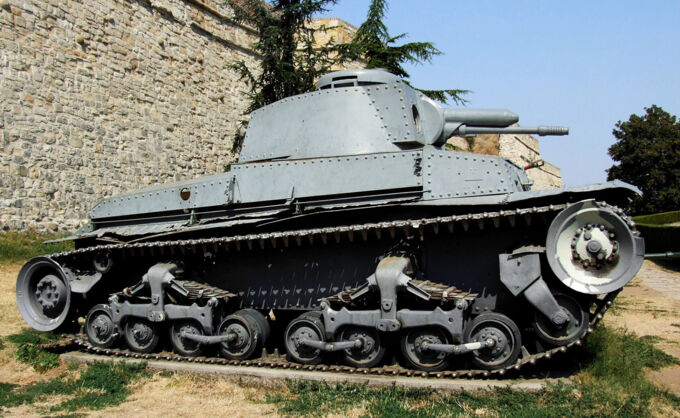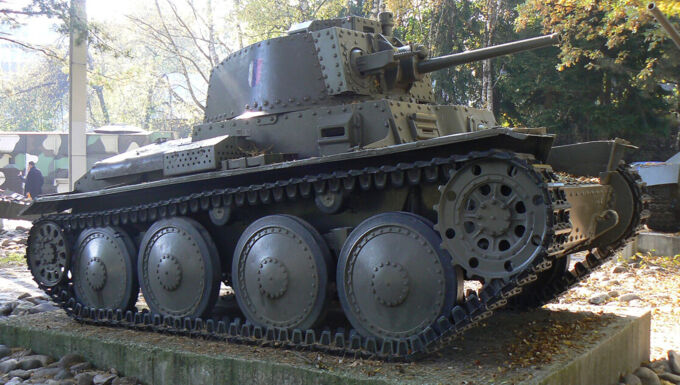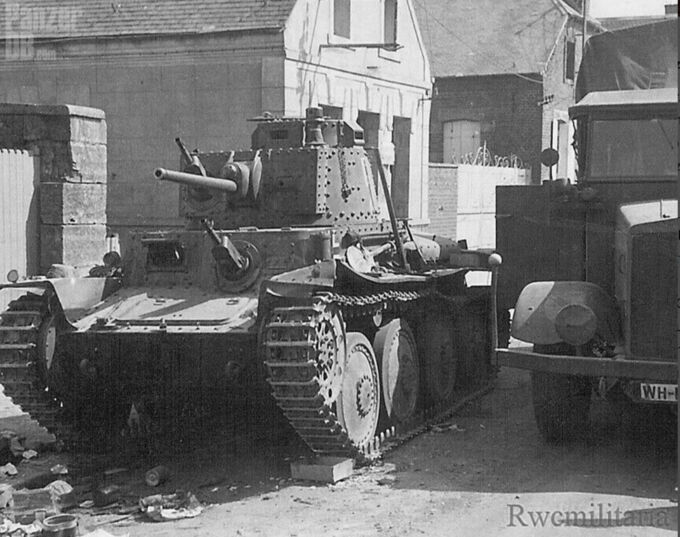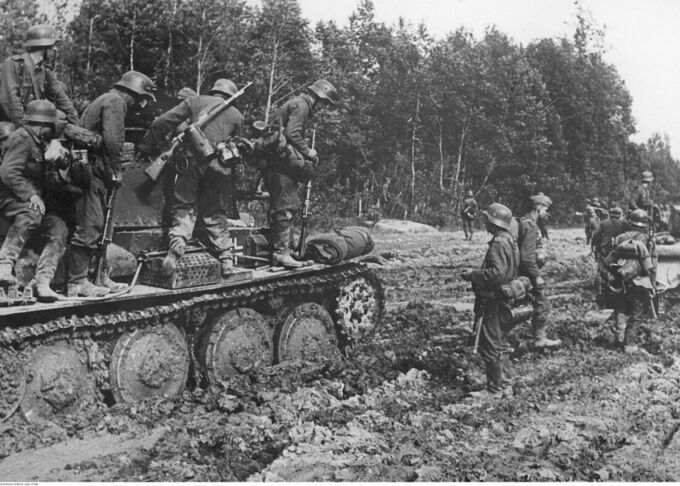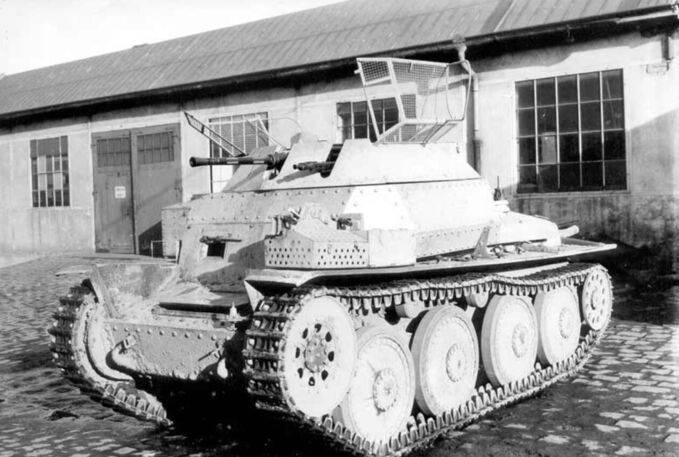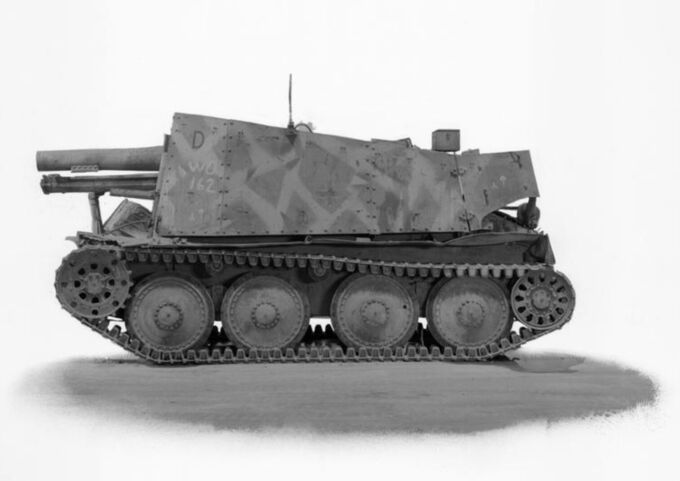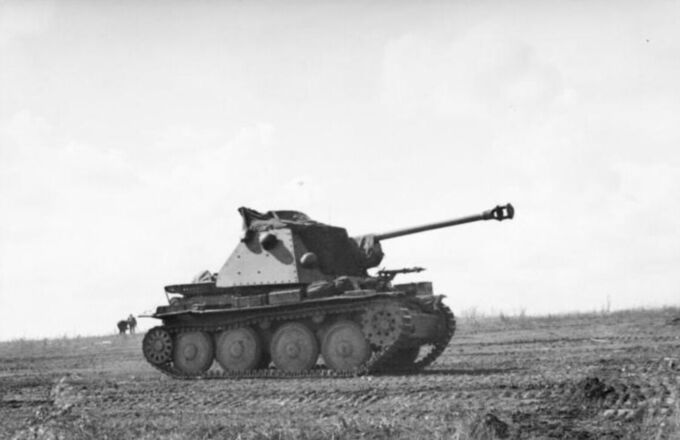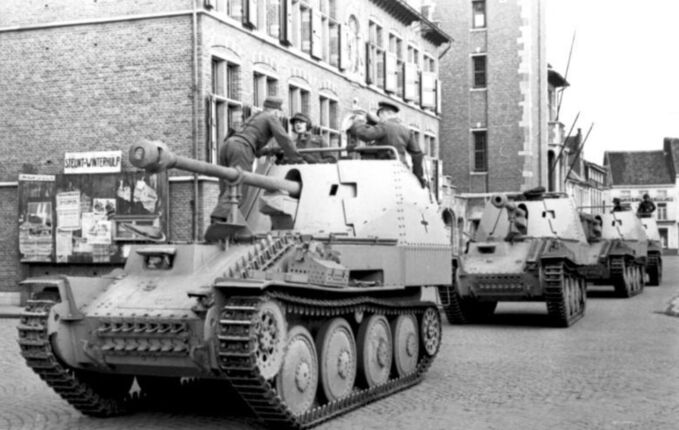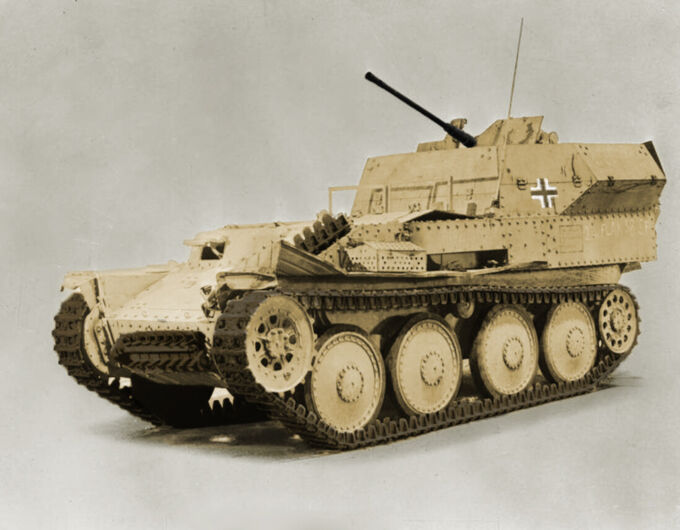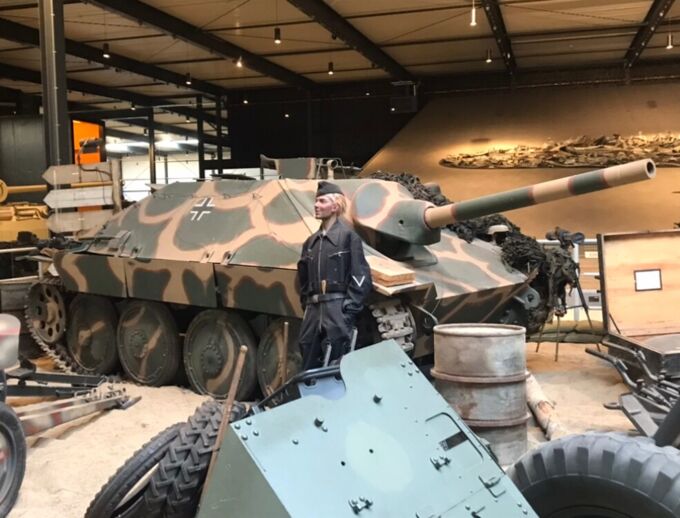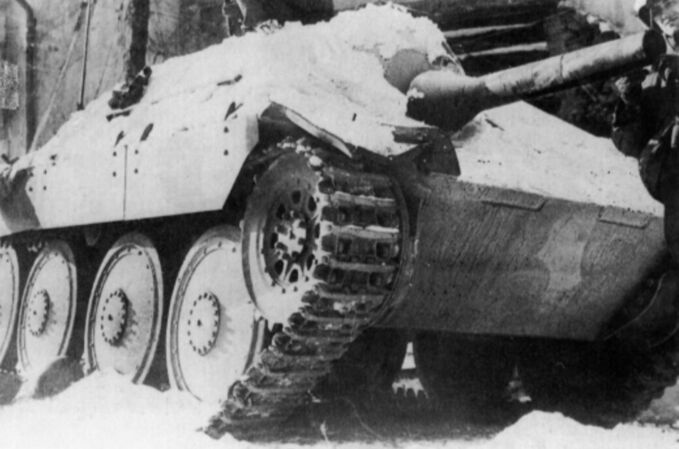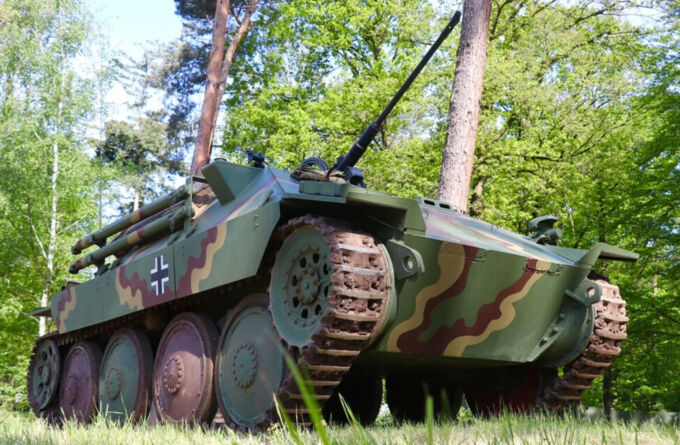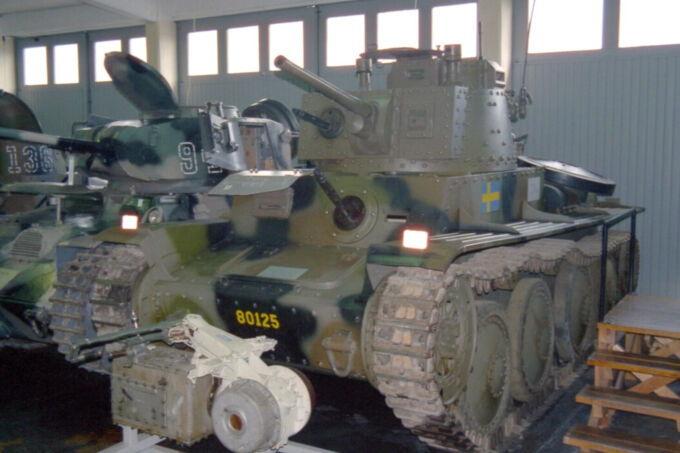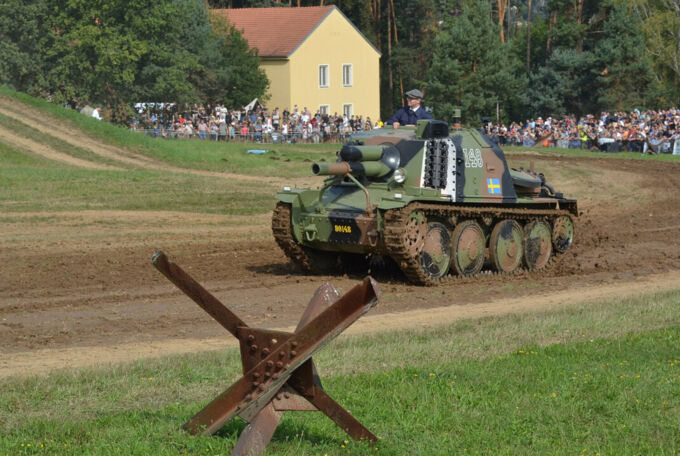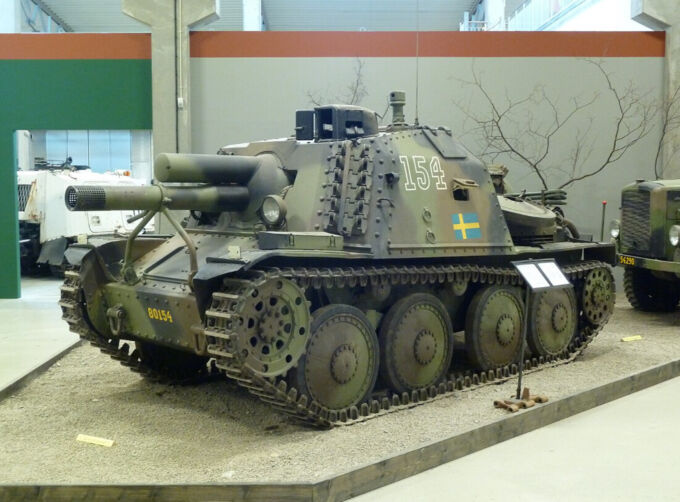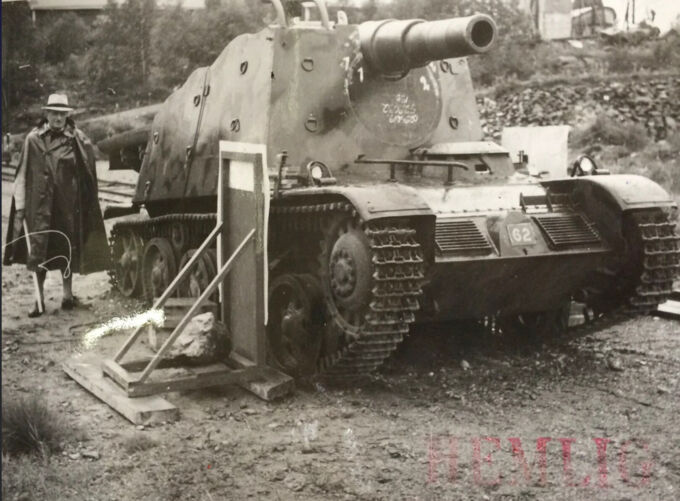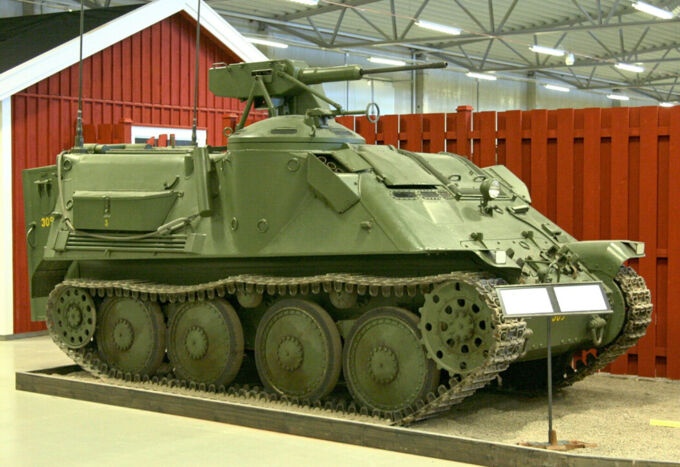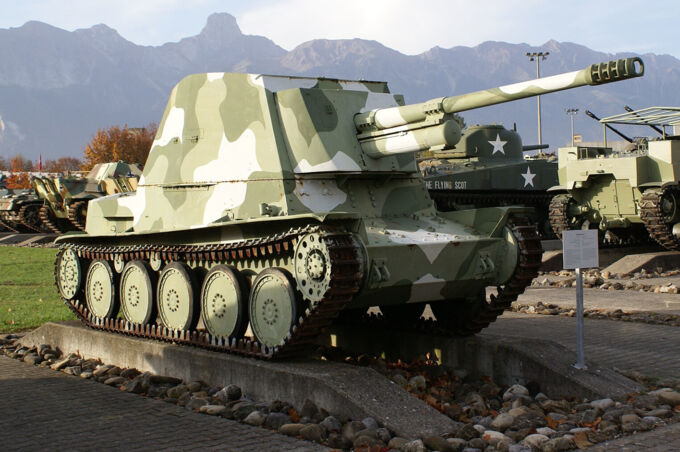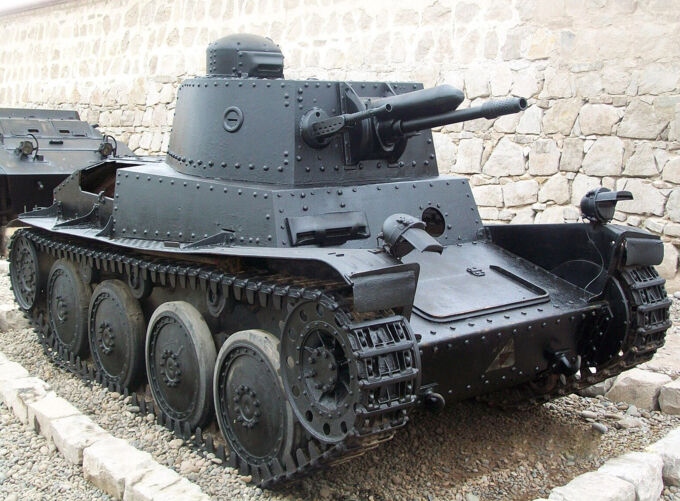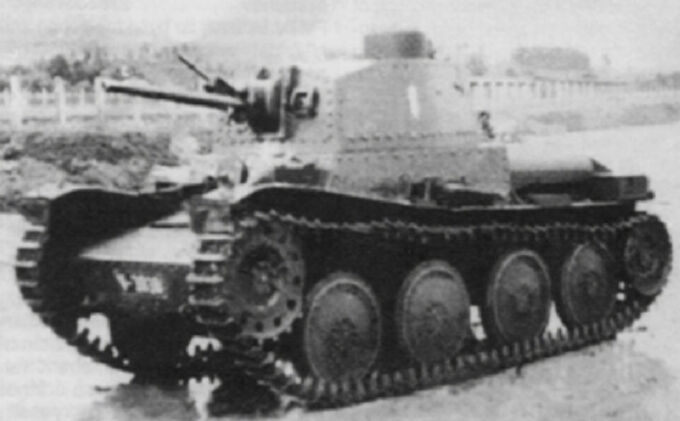The LT vz.38 was a light tank originally from Czechoslovakia and built by Škoda and ČKD. A total of at least 6,919 examples were built, including pre-war and licensed models in every imaginable configuration. Following the German occupation of Czechoslovakia in 1939, the German Reich captured plans, production equipment, and some examples of the LT vz.38 that had not yet been deployed in the Czech army and renamed them the Pz. 38(t). Later, a licensed version, along with some examples, was sold to Sweden, who renamed it the Stridsvagn m/41 and slightly modified it. The Pz. 38(t) was used by Germany throughout World War II and also influenced several other tank designs, including the German E-series.
Interesting fact: Do you know the 't' in Pz. 38(t) doesn’t refer to the tank’s weight, but rather to its origin. This type of designation was generally used in the German Army during and before World War II. The initial letter of the respective country was added to the end of the tank or the weapon, for example: Panzerspähwagen 7TP (p) = 7TP (Poland), Kreuzer-Panzerkampfwagen MK.VIII (e) = Cruiser Tank MK.VIII (England), Panzerkampfwagen P40 737 (i) = Carro armato P26/40 (Italy), Panzerkampfwagen M4 748(a) = M4 Sherman (America), KW.II 754(r) = KV II (Russia). For a few captured models, an additional code number was added to register the tank. Ironically, tanks from allied nations such as Italy which the Wehrmacht were also labelled with this regulation.
Development
In 1935, the Czechoslovak tank manufacturer ČKD was looking for a replacement for the LT vz.35, which it was producing jointly with the Škoda factory. The LT vz.35 was complex and had several shortcomings. ČKD expected orders from both the ever-growing Czechoslovak army and also intended to export to various countries.
ČKD opted for a leaf-spring chassis with four large wheels for its new tank, which achieved export success under the name “TNH.” With minor variations for each customer, 50 units were exported to Iran (TNHP), and 24 each to Peru (LTP) and Switzerland (LTH). Lithuania also ordered some (LTL). The British Royal Armored Corps (RAC) delivered a test model to the Gunnery School in Lulworth on March 23, 1939. One report stated that “the front gunner could not comfortably recline because the radio interfered with his left shoulder.” The report also noted that the vibrations while driving made it impossible to aim the gun. Even at a speed of 8 km/h, accuracy was inadequate. As a result, the British did not purchase the LT-35, and the experimental model was returned.
In the fall of 1937, the Czechoslovak armed forces launched a competition for a new medium tank. Škoda, ČKD, and Tatra participated. Škoda Praga submitted the aforementioned jointly produced export model. ČKD also submitted a separate prototype, the intriguing V-8-H (designated ST vz.39), which, however, suffered from numerous mechanical problems. Tatra, primarily known for its smaller wheeled armored vehicles, submitted an application presenting a completely new concept that completely changed the design of a tank. The concept was patented in 1938. On July 1, 1938, Czechoslovakia ordered 150 TNHPS models, but by the time of the German occupation (March 1939), none had entered service, and they were captured by the Wehrmacht.
Czechoslovakia
LT vz.38
150 LT vz.38 were built by Czechoslovakia. Weighing 9.5 tons, with a crew of four, and riveted armor ranging from 15 mm to 25 mm, it offered good protection for its time. Its 3.7 cm KPÚV vz.34 or vz.38 cannon had a penetration of 30 mm at 500 m, supplemented by two 7.92 mm ZB vz.37 machine guns.
It was powered by a 125 hp Praga 6-cylinder engine and could reach speeds of up to 42 km/h. The chassis featured four large double road wheels and leaf springs, ensuring good off-road capability.
Germany
Over 1,400 armored combat vehicles were produced for the Wehrmacht from 1939 to mid-1942. The external appearance of the vehicles differed little from that of the LT vz.38, as the main technical components, the chassis and drivetrain, remained completely unchanged, thus preserving the basic shape of the vehicle. At the beginning of the war, the main armament was considered sufficiently powerful to be able to compete with the enemy’s regular tank types, which is why it was not replaced until 1942.
Pz. 38(t) Ausf. A
The first version of the Panzerkampfwagen 38(t), Version A, was produced in a limited number of 150 units. Version A had a 3.72 cm KwK 38(t) L/47.8 as its primary armament and two ZB vz 37 (MG 37(t)) machine guns as its secondary armament. The armor was between 15 and 25 mm thick. It was powered by the Praga EPA 6-cylinder gasoline engine, which produced 150 hp and could accelerate the tank to 42 km/h (26 mph) and give it a range of 250 km (155 miles).
The engine and armament did not change between the various versions. The vehicles can be identified by the unarmored panoramic telescope mounted on the turret of the 38(t). During the Polish campaign, Panzerabteilung 67 mounted a horizontal antenna tube on the left side of the vehicle. A short shovel and a pickaxe were mounted across the round maintenance plate in the engine compartment. The road wheels had narrow rubber treads and wide steel tracks. The machine guns (MG 37(t)) had no flash suppressors.
Pz. 38(t) Ausf. B
Of version B, which comprised chassis 151 to 260, 110 were built. An armored protective cap was introduced for the head of the turret’s panoramic telescope. A sheet of metal was mounted over the turret’s optics to protect it from raindrops. A handle was added to the left side of the superstructure to make it easier for the crew to mount and dismount.
The antenna mount was kept simple, and additional parts for mounting the “combat antenna” of version A were omitted. The shovel and pickaxe were mounted on the track guard plate on the left side of the vehicle and remained there until the end of tank production. The road wheels were modified and featured wider rubber treads and a narrower steel rim.
Pz. 38(t) Ausf. C
During production of version C, which comprised chassis models 261 to 370, i.e., 110 vehicles, the frontal armor plate was reinforced from 25 mm to 40 mm. The plate mounts were modified, and the pins securing the final drive were protected. A three-piece cover was installed to protect the turret ball bearing and prevent it from jamming after being hit by infantry fire. A stopper was mounted on the side of the vehicle behind the first road wheel to reduce the chassis rocking while driving.
Pz. 38(t) Ausf. D
The 105 vehicles of the D version, chassis 371 to 475, received a minor modification to the riveting of the upper, curved frontal armor for the driver and machine gunner. All Ausf. D vehicles had a 40 mm front armor plate like the Ausf. C. The Czechoslovak antenna base mount was replaced with a German rubber-mounted model during production. During production of the Ausf. D, a new, lighter cast track was also introduced, with wider and shorter guide teeth that were beveled inward to prevent the tracks from throwing.
Pz. 38(t) Ausf. E
The Ausf. E, which may have comprised 275 examples (exact figures differ between different sources), introduced an important production change that would be characteristic of subsequent models. The previously curved upper frontal armor in front of the driver and machine gunner/radio operator was replaced with a straight armor plate. The armored viewports for the driver were reinforced. The two sections of the roof hatch above the radio operator’s position were now rectangular. Starting with this model, the side armor in the upper frontal area was extended to the new frontal plate. The turret front, the hull front, and the entire superstructure received additional armor by increasing the plate thickness to 30 and 25 mm, respectively. Overall, the number of rivets was reduced.
All E versions had an armored antenna base mounted on the front left of the superstructure. The track tensioners and the starter crank guide received armored covers. Starting with vehicle no. 624, the exhaust system was officially mounted higher to complement an armored smoke detector at the rear of the vehicle. A fifteenth leaf spring was added to the leaf spring assemblies of the front road wheels. The rear clearance light and brake light were repositioned with new brackets, one on the left and one on the right, above the chain guard; both were previously mounted on vertical brackets on the rear engine cover, left and right, respectively.
Pz. 38(t) Ausf. F
Approximately 250 of the F version were built; exact figures are unavailable due to conflicting sources. On the F version, the right rear spare track link mounts were enlarged to accommodate a third track link. During production, the number of rivets on the sides of the engine covers was reduced. Also during production, the Notek headlight was relocated from its previous position on the front right track guard to the front left corner of the upper horizontal front armor plate.
Pz. 38(t) Ausf. S
Version S was originally planned for export to Sweden and was called the TNHP-Sv. However, it was never delivered because Czechoslovakia was conquered by Nazi Germany, and the Wehrmacht took over the order from Sweden. Production continued from mid-1940 to early 1941 after completion. It received the chassis numbers 1001 to 1090, meaning 90 vehicles were built. This version S was developed in parallel with the production of version D. Due to the timing of the development, only the front plates were reinforced; the turret and hull sides only received 15 mm of armor. Since the turret armor on the sides was no thicker, the spall ring was the same size as versions C and D.
Six bolts on the upper edge of the upper front plate served to supplement 25 mm of additional armor. The frontal armor rivets on version S corresponded to the early versions A to D, with the front lateral row of rivets on the front turret extension having 5 rivets rather than 6 on versions A to D and 4 on versions E to G. The chain tensioners and the starter crank guide received armored covers. The exhaust was raised to accommodate the smoke plug release device.
Pz. 38(t) Ausf. G
Version G was the last German version of the Pz. 38(t). It had chassis numbers 1101 to 1359 and 1480 to 1526, a total of 306 vehicles (here too, sources disagree on exact numbers). These received further reinforcement of the armor to 50 mm plate thickness on the front armor of the hull and turret. The number of rivets and bolts was further reduced, particularly in the front area. In November 1941, with vehicle number 1220, additional mounts for replacement track links were introduced. Seven track links on the front bow armor plate and five each to the left and right of the maintenance hatch on the horizontal front armor. The small mirror for the driver on the left track cover was immediately eliminated from series production. From February 1942, Delbag air filters replaced the previous double air filters. To regulate the engine temperature, a slider was installed on the radiator opening on the rear engine compartment cover. In May 1942, vehicle No. 1481 was made suitable for tropical use and subsequently went into trials to test the performance of the Pz. 38(t) in tropical regions.
Pz. 38(t) n.A.
The Pz. 38(t) n.A. (Neue Ausführung = new version) was built in 1941 by MAN, Daimler-Benz, and ČDK, using five prototypes based on experience gained from the Polish campaign in 1939 at the beginning of the war. The Pz. 38(t) had a more powerful 220 hp engine, larger tracks, and larger road wheels. The Pz. 38(t) n.A. did not have riveted armor, but rather welded armor, which increased its strength and durability.
Panzerbefehlswagen 38(t)
In the Wehrmacht, it was common practice, originally starting with the Panzerkampfwagen III, to equip a turret-mounted version of a combat vehicle with enhanced radio equipment as a command vehicle. In the early years of the war, such command vehicles were recognizable by a loop antenna on the rear of the vehicle. Such a variant was also built for most versions of the Panzerkampfwagen 38(t). In the command version of the 38(t), the bow machine gun was removed to make room for the additional radio equipment.
Aufklärungspanzer 38(t) Sd.Kfz.140/1
The Aufklärungspanzer 38(t) was developed as a stopgap measure when the Wehrmacht lacked reconnaissance vehicles in 1944. Therefore, between February and March 1944, 70 Panzer 38(t)s were converted to reconnaissance tanks. The turret of the Panzer 38(t) was removed and the hull raised. Instead of the 38(t) turret, the turret from an Sd.Kfz. 234/1 was used, as was its 2 cm KwK 38 cannon as its main armament. 25 vehicles each were assigned to the armored reconnaissance units of the 3rd Panzer Division and the Panzergrenadier Division Großdeutschland. Both units received an additional seven vehicles as replacements. The remaining six vehicles were assigned to squadron units.
15-cm-sIG 33 (Sfl.) auf Pz. 38(t) “Grille” Ausf. H Sd.Kfz 138/1
The first version of the Grille, the Grille Ausf.H, was based on a slightly modified chassis of the Panzerkampfwagen 38(t) with a rear-mounted engine, already known as the Geschützwagen 38. The hull was adopted with minor modifications; the front-mounted superstructure was wrapped around the 15 cm sIG 33 cannon and was open at the top. From February to June 1943, 200 vehicles (including one prototype) were produced at BMM in Prague, with another ten following in November 1943. The designation was “15 cm heavy infantry gun 33 (Sf.) on Panzerkampfwagen 38(t) (Sd.Kfz. 138/1) Ausf. H.”
15-cm-sIG 33 (Sfl.) auf Pz. 38(t) “Grille” Ausf. K Sd.Kfz 138/1
The second Grille production batch, the Grille Ausf. K, was based on a Panzer 38(t) chassis specially redesigned for self-propelled guns with a significantly modified hull structure, now designated the Geschützwagen 38 Ausf. M. This hull, designed for the Panzerjäger Marder III Ausf. M tank destroyer, with its engine located in the center, was adopted with minor modifications for the Grille and the Flakpanzer 38(t) Ausf. L.
By relocating the engine, the 15 cm infantry gun could be positioned at the rear of the vehicle, which improved the vehicle’s balance. 162 Grille Ausf. K vehicles were produced from December 1943 to September 1944. The official designation was “15-cm-schweres Infanteriegeschütz 33 (Sf.) auf Geschützwagen 38 M (Sd.Kfz. 138/1) Ausf. K.”
Munitionsträger “Grille” Sd.Kfz 138/1
In addition to the 162 Grille Ausf. K vehicles, 102 ammunition carriers without weapons were built between January and May 1944. These could be used by field maintenance troops to remove the infantry gun from a damaged Grille and transfer it to an ammunition carrier, thus restoring it to combat-ready condition (just like the “Wespe” self-propelled howitzer and the Panzerwerfer 42).
Geschützwagen Grille mit 3-cm-Flak 38/103 Sd.Kfz 138/1
Later in the Second World War, a few chassis were fitted with a 3 cm Flak 103/38 instead of the heavy 15 cm gun, which was used as an anti-aircraft vehicle.
Marder III Sd.Kfz.139
In the first series of the Marder III, initially known as the Panzerjäger 38(t), the 7.62 cm PaK 36 (r), the Soviet 7.62 cm F-22 field gun, which had been captured in large numbers, was mounted on the unchanged hull of the Pz. 38(t). The gun was modified; among other things, the chamber was lengthened to achieve a higher muzzle velocity with the more powerful propellant charge of the PaK 40. Due to its design, the vehicle was very high. The gun crew was positioned above the engine compartment at the rear, where they were only lightly protected and there was no armor protection above or to the rear.
Originally designed for the Eastern Front, the vehicle was briefly delivered to the German Afrika Korps. The British troops were so impressed by the Marder III that they believed it was an 8.8 cm anti-aircraft gun. It carried 30 rounds of ammunition. 344 vehicles were built from April to November 1942.
Marder III Ausf. H Sd.Kfz.138
The later Marder III Ausf. H variant, like many Marder IIs, was equipped with a German 7.5 cm PaK 40 as its main weapon. The design of the gun’s armor plating was improved and significantly enlarged at the sides.
The fighting compartment was also slightly lowered. It carried 38 rounds of ammunition. 275 vehicles were built from November 1942 to April 1943, and a further 175 were converted from Pz. 38(t) vehicles returned for repair.
Marder III Ausf. M Sd.Kfz.138
For the final production series, the chassis of the Pz. 38(t) Ausf. M, which had now been specially redesigned for self-propelled guns, was used. The engine was relocated to the center of the hull, and the fighting compartment was moved to the floor at the rear of the hull. This also improved splinter protection for the crew, as the fighting compartment was now enclosed at the rear, although it remained open at the top. The redesigned driver’s front also offered better protection against fire.
27 rounds of ammunition were carried. With 942 units produced, the vehicle, now called the Marder III Ausf. M, was the most-produced version of the Marder series and proved to be an effective, but vulnerable, tank destroyer in service on all fronts. Production of the Ausf. M ran from May 1943 to May 1944, after which production was switched to the more effective and better-armored Jagdpanzer 38 “Hetzer.”
Flakpanzer 38(t) Ausf. L Sd.Kfz. 140
The Flakpanzer 38 (2cm) Ausf. L was the first series-produced anti-aircraft tank for the German Wehrmacht during World War II. Manufactured between late 1943 and February 1944, with a total of 141 vehicles, it was used by some motorized units as an escort vehicle for armored units in defensive operations from 1944 onward.
Jagdpanzer 38(t) “Hetzer” Sd.Kfz. 138/2
The Jagdpanzer 38(t) “Hetzer” is a medium-sized German tank destroyer based on the Pz. 38(t) chassis. The Hetzer was armed with a 7.5 cm Pak 39 L/48 as its primary armament, and an MG 34 or MG 42 as secondary armament. Its armor was 8 mm to 60 mm thick, but the side armor was a disadvantage, absorbing 20 mm of armor.
Even though these were angled, like all four sides of the casemate, the side armor could be easily penetrated, even by outdated anti-tank rifles and other anti-tank weapons. The Hetzer was powered by a Praga PS 1 EPA AC/258 petrol engine which produced 160 hp and gave the Hetzer a top speed of 42 km/h on the road and 16 km/h off-road, with a range of 130-180 km. From 1944 until the end of the war, ČDK built 300 Hetzer chassis every month. A total of over 2,800 Hetzer chassis were built. The Hetzer’s cannon had a very limited traverse range of just 16 degrees, namely 11 degrees to the right and 5 degrees to the left. The Hetzer was used mostly on the Eastern Front, but also on the Western Front and, to a lesser extent, on the Italian Front.
Interesting fact: The designation “Hetzer” was mistakenly given to the Jagdpanzer 38(t). The name “Hetzer” was actually supposed to be given to the E-10, which was intended to replace the existing Pz. III and Pz. IV and was originally supposed to be called “Hetzer.” However, during production, Škoda reversed this, and the Jagdpanzer 38(t) received the nickname “Hetzer,” which, after the misunderstanding was resolved, continued to be used for the Jagdpanzer 38(t).
Jagdpanzer 38 (t) Ausf. D
The Jagdpanzer 38(t) “Hetzer” Ausf. D was a small-scale version of the Hetzer, which featured a diesel engine instead of the Praga PS 1 EPA AC/258 as an attempt to use an alternative engine for the Hetzer. It was also armed with the 7.5 cm PaK 39 L/70, which gave it increased firepower. Its side armor was also less angled, and the rear was adapted for the new engine. Only five prototypes were built in 1945.
Flammpanzer 38
The Flammpanzer 38(t) was a modification of the Jagdpanzer 38(t) in which the 7.5-ton anti-tank gun was replaced by a “Köbe-Gerät” flamethrower. The ammunition depot was also replaced by a 700-liter fuel oil tank, giving the flamethrower a range of 50 meters. With the help of so-called “ignition cartridges” (empty cartridges used to ignite the oil explosively), a maximum range of 60 meters could be achieved. The Flammpanzer retained its four-man crew, who now served as commander, driver, radio operator, and flamethrower operator. 20 Jagdpanzer Hetzer tanks were primarily converted to Flammpanzer 38(t) tanks before the Ardennes Occupation, where they were deployed.
Bergepanzer 38 Sd.Kfz.136
The increasing number of Jagdpanzer 38s in the Wehrmacht led to the development of the Bergepanzer 38. This vehicle had a continuous front plate without a main gun. An early version was equipped with a 2-ton makeshift crane, while in later versions the crane was removed and an optional dozer blade at the rear and 2 cm cannon could be attached. A total of 106 vehicles were produced, of which 64 were converted to the Bergepanzer 38(t).
Mannschaftstransportwagen Kätzchen
The Kätzchen personnel carrier was developed by Auto Union (Audi) starting in 1944, but never entered military service. The vehicle was to be powered by a Maybach HL5O engine with 180 hp. One of the two prototypes started was based on the chassis of the Panzer 38(t). This was blown up by the German troops themselves at the end of the war.
Sweden
Strv m/41 S-I
This first series of the Strv m/41 (Stridsvagn m/41 = Tank m/41) was built by Scania-Vabis in Södertälje under license from ČDK. It was armed with a 37 mm Bofors M/38 L/37 or L/40 as its primary armament and two 8 mm m/39 machine guns as secondary armament.
The Stridsvagn S-I was equipped with a Scania Type 1664 engine with 142 hp, which propelled the tank to 42 km/h. They featured stronger frontal armor, ranging from 8 mm to 25 mm, and a slightly modified design. The interior was enlarged by the installation of a straight rear plate. Deliveries took place between December 1942 and August 1943.
Strv m/41 S-II
In early 1942, it was decided to improve the Stridsvagn S-I model, which at that time had outdated features such as a weak main armament and a riveted hull. However, its reliability was such a great advantage that it was decided to build a second series, primarily with improved protection. The frontal armor was increased to 50 mm and the weight increase due to the use of the more powerful 160 hp Scania L-603 engine was incorporated. This required an increase in the engine compartment and thus stretched the chassis by 65 mm. The difference is clearly visible in the middle, where on this model the two center road wheels are further apart than on the Stridsvagn S-I. The amount of fuel carried was also increased from 190 to 230 liters, which also increased the range. 122 units were ordered in June 1942, but deliveries stopped in March 1944 at the 104th example. The last 18 examples were converted to the SFL Sav m/43.
Sav m/43 (1944)
The Sav m/43 (1944) (Stormartillerivagn m/43 (1944) = Assault artillery carriage model 1944) arose from the Swedish General Staff’s demand for self-propelled artillery. In 1943, Scania-Vabis designed the Sav m/43 (1944) based on the Stridsvagn m/41 (Strv m/41). It had a turretless, fully enclosed superstructure, housing a 105 mm kan Sav m/44 L/21 cannon. Thirty-six of these vehicles were ordered in March 1944. This led to the discontinuation of production of the Strv m/41 SII, the last 18 units of which were completed as the Sav m/43 in 1944 and 1945. Since the planned 105 mm kan Sav m/44 cannon was not yet available, they received the 75 mm kan m/02 cannon by Bofors.
Sav m/43 (1946)
By March 1946, the Sav m/43 (1944) were completely equipped with the original 105 mm kan m/44 Sav L/21 and were then renamed Sav m/43 (1946) (Stormartillerivagn m/43 (1946) = Assault artillery carriage model 1946), as well as 18 additional vehicles directly produced with the 105 mm kan m/44 and delivered to the Swedish Army by 1947. They were in service with the Swedish Army until 1973.
Spj fm/43-44
In parallel with the development of the Sav m/43, KAFT, in collaboration with Bofors, continued to test ideas for SPG requirements on the Strv m/38 chassis. By July 1943, the vehicle was again converted, this time with an experimental 15 cm recoilless gun based on the 15 cm Fsthaub m/02 fortress gun. The overloaded and cramped chassis suffered from a low rate of fire and poor mobility. Despite the obvious design drawbacks, serious consideration was given to converting 12 Strv m/38s as a quick and easy alternative to the Sav m/43. During tests with the prototype in 1943, the army chiefs and KAFT representatives realized that they needed to redesign the chassis to make room for the gun, engine, and crew.
This resulted in the final model of the Stormartilleripjäs fm/43-44. The driver and machine gunner retained their positions in the bow. The engine and fuel tanks were relocated to the center of the vehicle, and the commander, gunner, and loader found their place at the rear with the 15 cm cannon. Now based on the Strv m/41 S-II and weighing 10 tons, the project was canceled in 1945.
Pvkv III
The Pvkv III (Pansarvärnskanonvagn III = Armor defense cannon car III) was a Swedish tank destroyer based on the Strv. m/41 S-II chassis. The Swedish General Staff demanded not only self-propelled artillery but also tank destroyers built on previously available tank chassis. Landsverk therefore presented the Pvkv III, a Strv m/41 S-II with a large, square cannon that was open at the top. It was armed with a 57 mm Pvkv m/43 cannon as its main armament.
Pvkv II
The Pvkv II (Pansarvärnskanonvagn II = Armor defense cannon car II) was a further development of the Pvkv III and differed little from the Pvkv III, namely the Pvkv II was armed with a 75 mm lvkan m/37 instead of the weaker 57 mm Pvkv m/43.
Pbv 301
The Pbv 301 (Pansarbandvagn 301 = armored tracked carrier vehicle 301) was an infantry fighting vehicle of the Swedish Army based on the Strv m/41 S-II. It was designed in the 1950s. It was intended to be able to carry a squad of 8 soldiers and provide them with covering fire. The Pbv could do this with the help of a 20 mm Akan m/45B autocannon, but it was also possible to install an 8.4 cm Grg m/48 recoilless anti-tank weapon instead of the auto cannon, or even a 6.5 mm Ksp m/58A machine gun.
The vehicle could reach a speed of 45 km/h with the help of its 160 hp Svenska Flygmotor B44 gasoline engine. 8-50 mm of armor offered protection to the occupants. There were three variants of the Pbv: the standard variant, which comprised 185 vehicles; a command variant, of which 20 were built; and a version intended to serve as an artillery observer, of which 15 were built. These were in service with the Swedish Army between 1961 and 1971.
Switzerland
LTH
The LTH was designed by ČDK for Switzerland in 1937. The LTH featured a 2.4 cm cannon (24 mm Pzw-Kan 38) and a 7.5 mm MG 11. It had a 126 hp Saurer 4-cylinder diesel engine, which propelled the LTH to a speed of 45 km/h and a range of 250 km.
In 1938, Switzerland purchased one LTH tank from ČDK. The following year, it purchased eleven more. These tanks had a 120 hp six-cylinder gasoline engine. In 1941, Switzerland purchased another twelve LTH tanks. These were delivered disassembled and without armament or engine. These twelve were equipped with a four-cylinder 125 hp diesel engine from the Swiss company Saurer. All were armed with the 24 mm Pzw-Kan-38 cannon, a predecessor of the 24 mm Tankbüchse 41, and were designated Panzerwagen 39.
Nahkampfkanone 1
In 1943 and 1944, Switzerland gained its first experience in designing and building its own armored vehicles. The Nahkampfkanone 1 (CKD-Praga LT-H) was built by the Berna company in Olten on a chassis of the Panzerwagen 39 (ČKD-Praga LT-H). This version was a further development of the LT. vz. 38, which was extended by one road wheel. However, since spare parts were scarce, some parts from the Panzerwagen 39 were used, primarily for the chassis and transmission.
The vehicle was powered by a 6-cylinder, four-stroke, in-line Saurer CT1D engine with 123 hp, which could accelerate the Nahkampfkanone to 55 km/h on the road and 25 km/h off-road. The vehicle was merely a makeshift construction. Its armor consisted of 25 to 55 mm thick sheet metal, and the superstructure was provisional. In the initial trials, a 7.5 cm cannon was used, followed later by a 10.5 cm howitzer. Only later was the superstructure closed at the top and rear. Only one example was built, which was used by the troops for trials from 1944 to 1947.
G-13
The Škoda factory received an order from Switzerland for 158 Hetzer vehicles. Switzerland considered the Hetzer’s small silhouette ideal for use on the narrow paths and roads of the Swiss mountains. These vehicles were delivered to the Swiss Army from October 1946 until February 1950, where they remained in service under the designation Panzerjäger G13 until 1973.
After production ceased in Czechoslovakia in 1950, a total of 86 tanks were converted to the Swiss Saurer-Arbon 8-cylinder diesel engine with Allison transmission between 1952 and 1954 due to a lack of spare parts. The biggest differences between the G13 Panzerjäger and the Jagdpanzer 38 “Hetzer” were that the G13 Panzerjäger had a StuK L/48 from the StuG III G as its main armament, while the Hetzer had a 7.5 cm L/48 PaK 39. The remotely controlled machine gun above was replaced by a panoramic periscope. The commander and loader swapped positions inside the tank. The gasoline engines that were standard equipment in the Hetzer were gradually replaced by diesel engines by 1973.
Peru
LTP
The LTP (LTP = Light Tank Peru) was the Peruvian variant of the LT vz.38 and LT vz.39, which were developed by Czechoslovakia specifically for export to Peru, and the first 24 units of the LTP were delivered to Peru between 1938 and the 27th February 1939. In Peru, it was designated Tanque Ligero 38/39M. It was armed with a 37 mm UV vz. 34 cannon as its main armament, as well as a heavy 7.92 mm coaxial ZB vz. 53 machine gun and a light 7.92 mm ZB vz. 30 machine gun mounted in the hull.
A Scania-Vabis 1664 engine accelerated it to 41 km/h on the road and 33 km/h off-road, giving it a total range of 187 km. After the Leticia conflict with Colombia, Peru sought to modernize its armed forces. The first LTPs, the Peru Bessas, were first used during a coup attempt in 1938 and played a significant role in the Ecuador-Peru War of 1941. Despite the subsequent delivery of 30 M3 Stuart tanks by the United States, Peru continued to favor the LTP due to its reliability. Peru attempted to acquire additional LTPs in 1947, but negotiations failed due to the political situation following the communist takeover of Czechoslovakia. Nevertheless, the LTPs remained in service until the 1980s.
Lithuania
LTL
The LTL (Light Tank Lithuania) was supposed to be the export version that was to be sold to Lithuania. 21 LTL version LT vz.38s were ordered by Lithuania, but not a single one of these 21 were delivered. Due to the Soviet takeover, these tanks were delivered to Slovakia.
Slovakia
LT-38
The LT-38 was the Slovak variant of the Pz. 38(t). In 1940, Slovakia ordered 10 Pz. 38(t) tanks, intended for Slovakia’s fast divisions. These were used in Operation Barbarossa, where only two were destroyed; the rest returned to Slovakia, which decided to order 27 more. With the 27 additional vehicles ordered, they received 37 more that had been retired from the Wehrmacht.
LT-40
After the LTL were not delivered to Lithuania, the 21 LTL were delivered to Slovakia where they were designated LT-40.
Hungary
T.38
In 1941, Hungary received around 100 Pz. 38(t) Ausf. G and Ausf. F. The frontal armor of these 100 was reinforced to 50mm and they received a new classification as medium tanks in Hungary and were renamed T.38 and were in Hungarian service until the end of the war.
Romania
TACAM T-38
The TACAM (Tun Anticar pe Afet Mobil) T-38 was a project designed by the Romanian kingdom in 1942 to build its own tank destroyer based on the chassis of the LT vz.38. A 76 mm ZiS-3 was planned as the main armament, but it was also considered to use a German 8.8 cm Flak or a 75 mm Reșița M1943. However, the design was rejected, and the TACAM R-2, based on the chassie of the LT vz.35 but with the 76 mm ZiS-3, was chosen with 21 vehicles produced.
Conclusion
The LT vz.38 served as the basis for many different tanks. From the Pz.38(t), LT-40, and the LTH, the LT vz.38 served as a solid foundation for their experience in building their own versions of the tank. The experience gained also flowed into their own projects, such as the German E-series, which also uses parts of the Pz.38(t). I thank every reader who read the entire article.
Sources
- [Wiki DE] Panzerkampfwagen 38 (t)
- [Wiki DE] Beutepanzer
- [Wiki DE] 15-cm sIG 33 (Sfl.) auf Pz. 38 (t) “Grille”
- [Wiki DE] Stormartillerivagn m/43
- [Wiki EN] German armored fighting Vehicle Production during World War II
- [Wiki EN] Stridsvagen m/41
- [Wiki EN] 3.7 cm ÚV vz. 38
- [Wiki HU] LT. vz. 38
- [Wiki PL] LT. vz. 38
- [Tanks Encyclopedia] Panzer 38 (t)
- [Tanks Encyclopedia] Flammpanzer 38 (t)
- [Tanks Encyclopedia] Jagdpanzer 38 Hetzer
- [Tanks Encyclopedia] Panzerjäger 38 (t) für 7.62 cm PaK 36 (r) Sd.Kfz.139 Marder III
- [Tanks Encyclopedia] Praga LTP Tanque Ligero 38-39m
- [Tanks Encyclopedia] Panzer 38 (t) in Hungarian Service
- [Tanks Encyclopedia] Panzer 39
- [Tanks Encyclopedia] Flakpanzer 38 (t) auf selbstfahrlaffete 38 (t) Ausf. M Sd.Kfz.140
- [Tanks Encyclopedia] Jagdpanzer 38 D
- [Tanks Encyclopedia] Aufklärungspanzer 38 (t)
- [Tank AFV] slG 33 auf SdKfz 38 (t) Ausf H M Grille
- [Tank AFV] Stridsvagn M41
- [KFZ der Wehrmacht] Aufklärungspanzer 38 (t)
- [Oorlogsmuseum NL] Bergepanzer 38 (t)
- [From the swedish archives] Swedish assalut guns sav m 43 stormartilleripjas fm 43 44

